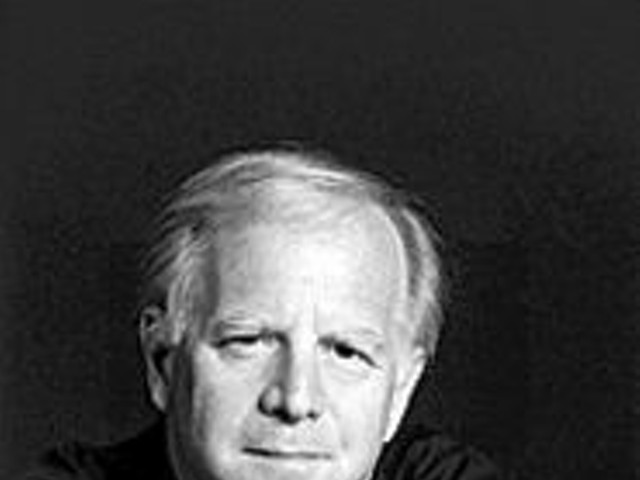Consider, for instance, the protagonist. John Proctor, who chooses death over indignity, is an authentic tragic hero. As The Crucible's reputation has grown ever more elevated with the passing years, we've come to believe that it takes a larger-than-life actor to fill Proctor's mud-caked boots -- an actor like Daniel Day-Lewis, who starred in the 1996 film version, or Liam Neeson, who recently played the role on Broadway.
So what are we to make of Christopher Burns' initially muted performance at the Rep? When Burns first appears onstage midway through the opening scene, he enters the small upper bedroom as if he doesn't even belong there. This is not the kind of "let me suck up the air" entrance that a Day-Lewis or a Neeson would make; this John Proctor is more laid-back than David Carradine on his way to the Kung Fu set.
After a few minutes it dawns on a viewer that Proctor has no business entering a young girl's bedroom, especially not when that girl is the niece of the lugubrious village parson, a man whom Proctor despises. So Burns' approach to the role, while initially against the norm of what we've come to expect, is completely justified. His entire performance -- which begins cautiously and then builds to a certain stature -- epitomizes a production that refuses to get ahead of itself, a production whose characters are defined by disarray and fear. Even as the hysteria in Salem swirls out of control, no one on the Rep stage anticipates what is coming next; there is no certainty here.
Obviously everyone involved with the show knows that the 51-year-old Crucible -- which was barely able to eke out a six-month run when it debuted on Broadway in 1953 -- is now revered as a masterwork. But director Steven Woolf has succeeded in erasing that knowledge from their minds. This studied ignorance has resulted in a mounting that does not seek to revive a classic; as staged here, The Crucible is as immediate as last month. When the self-righteous Deputy Governor Danforth pronounces, "A person is either with this court or he is against it," surely Miller was responding to the Bush administration's chilling charge of treason directed against anyone who had the temerity to challenge the post-9/11 clampdown on civil liberties. And when, after his clearly innocent wife is vengefully arrested for witchcraft, Proctor howls, "Is the accuser always holy now?" isn't Miller alluding to the vengeful excesses of the Swift-Boaters for Truth?
Despite its immediacy, one timeless component has eluded the Rep production. Although Miller has written that The Crucible is permeated by "the guilt of illicit sexuality" -- frustrated young girls have been dancing naked in the woods, the married Proctor has had a steamy affair with a seventeen-year-old serving girl -- that necessary sense of repressive sexual tension is sorely missing here. Without it, The Crucible loses its fulcrum.
Nevertheless, the Rep has forged an otherwise absorbing evening. The striking scenic design by Narelle Sissons frames the action in a kind of metaphorical vise; the slatted, slanted upstage wall ever threatens to close in and squeeze the townspeople into submission. The sunshine and moonlight that comprise Mary Jo Dondlinger's lighting design are barely able to peek through these slats, as if to remind the viewer that the light of truth is a precious commodity, easily blocked out.
Among the cast of twenty, Anderson Matthews bravely affects a nigh-operatic tone in the paranoid Reverend Parris -- it's a performance apart from everyone else, yet it's precisely what Miller calls for in his text. Bernadette Quigley's Elizabeth Proctor is understated and wan. There is nothing of the heroine about her; she doesn't even try to play on the audience's emotions during her taut cross-examination about her husband's admitted infidelity. Quigley doesn't ask the audience to sympathize with her, which is why -- like her husband -- ultimately she's so persuasive. As Mary Warren, a simple-minded girl who could stop the deception but instead turns from the truth, Olivia Keister has skillfully modeled her performance after the limp poppet-doll her character sews in court.
But of course the evening's most skillful figure is Miller himself. At age 88 he continues to rage against the dying of the light. (His newest drama, Finishing the Picture, opens at Chicago's Goodman Theatre this week.) Throughout his long and flinty career, Miller's works have provided a battering ram against what their author views as social injustice; now those same oft-produced dramas have elevated him to a kind of oracle. Abraham Lincoln may have spoken about "the better angels of our nature," but in The Crucible Miller hurls us back to earth and compellingly forces us to confront man's fearsome dark duality.
Nature is also at the core of Marat/Sade, the landmark verse play-within-a-play that assaulted Broadway in 1965. "Nature would watch unmoved if we destroyed the entire human race," argues the Marquis de Sade in the midst of a bizarre entertainment he is staging at the asylum to which he has been committed. No it would not, counters the inmate who portrays Marat, who was murdered in his bath during the bloody French Revolution: "The important thing is to pull yourself up by your own hair, to turn yourself inside out and see the whole world with fresh eyes."
The play's unexpurgated title is The Persecution and Assassination of Jean-Paul Marat as Performed by the Inmates of the Asylum of Charenton under the Direction of the Marquis de Sade, but really it's a debate about a) the need for revolutionary change, and b) man's inability to cope with that change. The didactic script was written by Peter Weiss, who was born in Germany, raised in Sweden and influenced by the severe theater of Bertolt Brecht. Hence we get no lighting changes, nothing that might manipulate the viewer. Actor and audience, we're all sharing this experience together. Well, maybe not completely together. There is, after all, a reassuring note in the playbill that "the patients have been warned not to touch you." (They are, however, allowed to touch themselves, and at least one inmate seems to derive great pleasure from the touching.)
"Woe to the man who is different," one character warns. "He shall be mocked by the blinkered guardians of morality." Sade deplores the "moral guardians" who would censor his play. (A viewer must remember that Marat/Sade takes place in 1808, in a society where Roman Catholic priests were quick to impose their beliefs onto the political discourse. Obviously that aspect of the play is no longer relevant to today's audience.)
Director Eric Little sometimes refers to his production as Marat/Sade: The Musical. It's a point well taken, because the evening abounds with song and vaudeville. Yet despite the play's inherent mayhem and melody, today it's hard to view it as much more than a historical curiosity.
Because Marat/Sade is staged so infrequently, this ECHO Theatre production offers a rare opportunity, not only for audiences to witness the perverse entertainment, but also for actors to indulge in its idiosyncrasies. The large cast is a veritable who's who of local actors, including Anna Blair, Chopper Leifheit, Sara Renschen, Kelly Schnider, and Doug Shelton as Sade.
It was a terrific idea to split the verbose role of the Herald (or narrator) between St. Louis favorites Lavonne Byers and Terry Meddows. Freed from the constraint of so many words, Meddows is allowed to romp through the evening. At the outset he is a Phiz illustration from Charles Dickens' Pickwick Papers come to life. But as the show proceeds and he loses control of what few wits he possesses, Meddows reminds one of a late-night movie where the sound is out of sync with the actors' lips. Here, Meddows' addled brain is at odds with his mouth. By evening's end he becomes pitiful and terrifying. This manic, ultimately seditious performance alone justifies a visit to Soulard.





